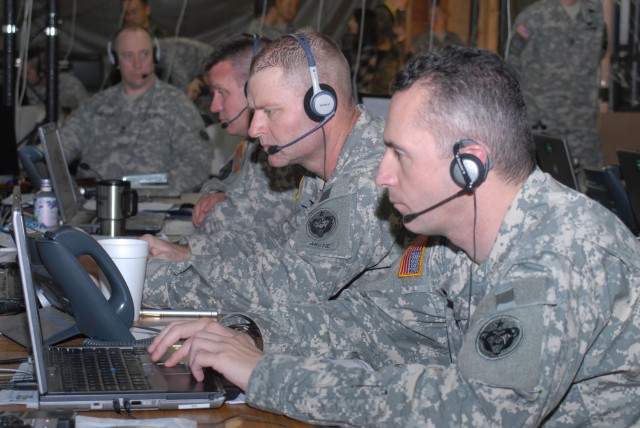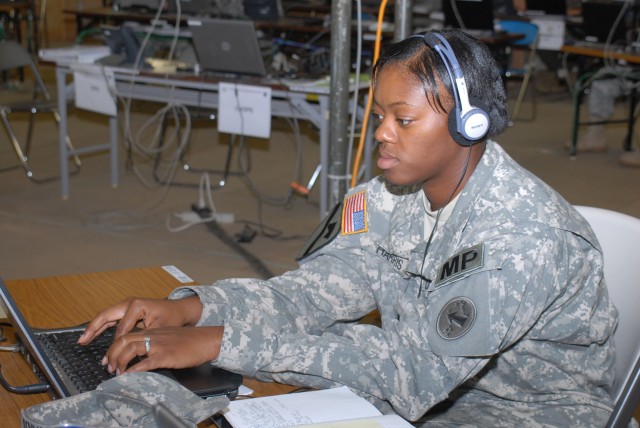CAMP ASAKA, Japan (December 10, 2008) - United States Army, Pacific and the Japan Ground Self Defense Force joined together Dec. 7-13 for Exercise Yama Sakura 55, considered one of the most important bilateral exercises of the year for USARPAC.
This exercise has concentrated on the enhancement of the U.S. Army and JGSDF efforts in the area of bilateral planning, coordination and interoperability since 1982.
Yama Sakura also has given the United States and Japan the opportunity to work as partners in support of the U.S.-Japan Security Alliance, and for continued peace and stability in the Asia-Pacific region.
"Yama Sakura is important for USARPAC for two reasons," said Lt. Gen. Benjamin R. Mixon, commander, United States Army, Pacific. "It's the first exercise for the Operational Command Post and the Main Command Post as the primary command and control headquarters. Secondly, it's important to our allies in the Japanese military."
Yama Sakura has four major training objectives: the exchange of ideas, techniques and military experience with the JGSDF, training a major U.S. operational command post and ground forces to deploy at a moment's notice, exercise the JGSDF and USARPAC's capabilities in the defense of Japan, and to prepare USARPAC forces for combined, multi-national and joint Full Spectrum Operations.
"This is the best training that we have experienced as an OCP far and away," said Col. Sean Callahan, OCP-Core Element director. "The bilateral aspects of this exercise have added to the realism because it helps simulate the type of environment we would normally fight."
"For this being the first time doing this type of mission, I think the collaboration between the U.S. and the Japanese is great," added Sgt Maj. Luis Cruz, OCP-CE sergeant major. "The information flow is going both ways which makes for great training for both staffs."
United States Army, Alaska, 29th Infantry Division, 94th Army Air Missile Defense Command, 8th Theater Sustainment Command, 18th Medical Command, the 3rd Marine Expeditionary Brigade are just a few of the units helping to make Yama Sakura a success. More than 1300 U.S. service members are in Japan supporting the exercise as well as several hundred in Hawaii.
Japan's Eastern Army played host to Yama Sakura 55. Both partners were able to learn each other's tactics, techniques and procedures and how to integrate as a command post in case of a real conflict in the future.
"This is the first time I've ever done an exercise like this," said Japanese Sgt. Noriko Shimoyama, signal branch. "At first I wasn't sure, but now I've learned how (the U.S. Army) works. Everything is new and interesting."
"Japan is one of our best allies in the Pacific," added Col. Oscar Hall, operational maneuver director from United States Army, Alaska. "It is a great honor to work with them on our TTPs. We're going forward and building something together."
Exercises like Yama Sakura provide the United States and its allies the ability to train in peace to thwart those who prepare for and contemplate creating instability in the region.
In addition to the training, U.S. service members will participate in the hosting of Japanese veterans of World War II for a day, and participate in several cultural awareness events, including a home visit where Japanese families host U.S. service members in their homes for a traditional Japanese meal.
"I think one of the greatest aspects of this is the personal relationships at both the senior and Soldier level," Hall said. "It's something to witness when a Soldier takes off his patch and trades it for a patch from his Japanese counterpart. That is Soldiering at its finest."
"The Soldiers are doing a great job," Mixon said. "They are building good relationships with the Japanese and at the same time, perfecting our warfighting capability."
Yama Sakura is just one of the five bilateral exercises in which USARPAC and Japan participate. Next year, USARPAC will be one of the major participants in exercises with the Japanese Defense Forces including Keen Edge, Northwind, Orient Shield, and Rising Warrior. Additionally, the 2009 Pacific Armies Management Seminar will be held in Tokyo.
All of these exercises and events are essential in enhancing the growing military partnership between the United States and Japan.




Social Sharing